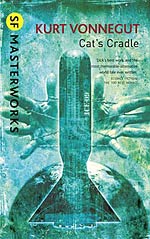
![]() couchtomoon
couchtomoon
6/24/2014
![]()
"No damn cat. No damn cradle." (ch. 74)
When listless Newt Hoenikker, listless son of the dead co-creator of the atomic bomb, makes this statement, I can only settle back in comfort, knowing that this is a writer who gets me. He's right. That arrangement of string doesn't remotely resemble a cat's cradle, and what the hell is a cat's cradle anyway?
Obviously, the story is about more than just the string, but it's a cynical idealist's response to a world that wants us to see something that just isn't there. The atom bomb will create peace. Patriotism is family. Religion is truth.
John, but call him Jonah, tells the story about a time he attempted to write a book about the creation of the atomic bomb. His research first leads him to Ilium, New York (Troy, perhaps) to visit with the children and former coworkers of Felix Hoenikker, co-creator of the atom bomb. In his research, he learns that Hoenikker may have also toyed with the idea of creating a world-destroying device called ice-nine, which has the potential to turn any moisture, including entire oceans, to solid ice. John follows his research to the impoverished Caribbean island of San Lorenzo, where the people are ruled by an inept monarchical president, and whose infrastructure is primarily financed by an American overseas sugar company. The people of San Lorenzo follow a curious religion called Bokonism, outlawed on the island, punishable by death, but popular among the locals regardless of, and probably due to, its prohibition. The president passes his rule to John just before his suicide by ice-nine, which spurs a series of events that lead to an apocalypse of frozen oceans and wormy tornadoes.
It's no shocker that Vonnegut's story espouses political commentary-- that's what he's known for, and it's why I was drawn to his stories during my most politically active years. But he also excels at the craft of storytelling. His characters are rich studies of American idiosyncrasies, ranging from the educated to the ignorant, and everyone in between. In Cat's Cradle, John is an anti-hero in the classic sense, someone just floating along on the tides of the tale, casting amused conversational reflections to the stronger personalities around him, but not really committing to one opinion or another.
Those stronger personalities convey Americanism at its most eccentric ends. We meet Claire Minton, wife of a diplomat and professional book indexer, who advises, "'Never index your own book,'" while she explains in another place, "'it's a shameless exhibition—to the trained eye'" (ch. 55). And H. Lowe Crosby, a hopeful bicycle mogul of San Lorenzo, who hates "pissants" and knows exactly how to identify them (ch. 59). And don't forget Crosby's wife, Hazel, who makes all Hoosiers call her "Mom." Then, there's Phillip Castle, sugar heir, reluctant next president of San Lorenzo, and unabashed Bokonist, who shares the story of a ship carrying wicker furniture and rats that crashed ashore, moralizing that "... some people got free furniture, and some people got bubonic plague" (ch. 73). Castle happens to be a pissant.
Vonnegut knows Americans, and he characterizes them well. I have encountered every one of the people described above. On the other hand, his native islander characters are rather bland and underdeveloped. President "Papa" Monzano, not nearly as bloodthirsty as his likely namesakes, (Haiti's "Papa Doc" and "Baby Doc" Duvalier), greets his visitors, gets sick, bequeaths his presidency to John, and commits suicide. We learn little of his personality and motives. His adopted daughter, Mona, the San Lorenzan beauty and xylophone virtuoso, has a strange purpose in the story, existing only as a siren to lure John to the island. Her role later expands, yet she remains a quiet enigma for the rest of the book, except for the occasional Bokonist philosophizing. Vonnegut won't explain her-- Mona is just as untouchable and mysterious to the reader as she would be to any black sock & sandal-wearing American male tourist. It would be nice to see Mona with more depth, but her role is designed to perplex John, and her ambiguity suits the story.
And even for most modern male (and female) writers, giving Mona depth would mean strapping a gun to her leather-clad thigh. I'll pass.
If John is a classic anti-hero, Bokonism is the anti-religion: floaty, nebulous, unconcerned. For a 200-page novel, Vonnegut's Bokonism is one of the richest religious constructs one can encounter in SF. Not only does it feel real and convincing, while also being humorous, it's likely to convert the reader to its practical sophisms. I'm surprised the sixties didn't breed a bunch of Bokonists, sprouting churches on every street corner. (I'm surprised my own parents didn't become Bokonists.) I could go on about Bokonism, and with its karasses, granfalloons, wampeters, and boko-maru, but you'd be a pissant if you didn't read it to find out for yourself.
It's a 4 to 6-hour read, with nearly as many chapters as pages (127 very short chapters!), so it's worth a glance some weekend afternoon when you want to read something brief and brilliant, playful and insightful.
It's Kurt at his best. And it's another book that deserves an annual reread.
http://couchtomoon.wordpress.com